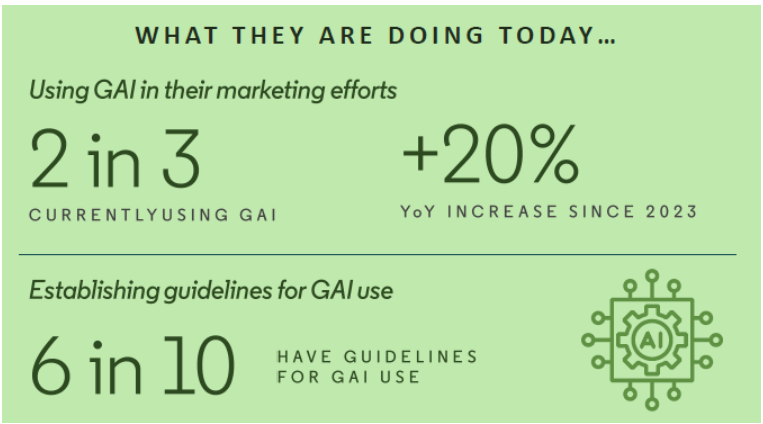The most successful marketers are lifelong learners who thrive by adapting to change. And the last decade has given us plenty of opportunity to practice flexibility and adaptability. As we get used to the idea that there will be no “new normal,” we can still learn from what other marketers are doing (or not doing, for that matter).
Our client LinkedIn just published their 2024 B2B Marketing Benchmark. It’s just the kind of data we marketers need to move our art and science further.
LinkedIn surveyed 2,000+ B2B marketers in management, leadership or executive positions to find out what teams are doing now and what they’re planning for the future.
Here are the key takeaways our team spotted.
Today, tomorrow and beyond: The future of B2B marketing
Despite the tumultuous economic times of the past few years, the 2024 Benchmark finds marketers adapting and preparing for what comes next. Let’s dig into the data and what it means for your team’s future success.
Strategic thinking is essential
Without a continuously-developed strategy, marketers are left to react instead of act. The data shows that most marketers got that message: Over two-thirds plan to reorganize their teams this year to be more effective.
Marketers are also carefully allocating resources across channels, with a strong focus on digital. In fact, of the top five most valuable channels, only one (trade shows/live events) is non-digital.
Strategic marketers are seeing the biggest returns from:
- Social media
- Events
However nearly half of marketers plan to increase investments in video, influencer content and case studies in the coming year. It’ll be intriguing to see how these investments paid off, when we’re looking at next year’s data.
All this strategizing is paying off: a whopping 90% said they feel good about their ability to drive revenue. This confidence is rubbing off on the finance department as well: 51% say their budget increased this year, and 54% expect an increase next year. Within that 54%, 18% say they expect a substantial increase.
Room for improvement: Acquisition vs. retention
CMOs report they’re spending 60% of resources on acquiring new customers, and only 40% on retention. That balance could shift in favor of retention with a focus on customer lifetime value for even better results.
Generative AI hits the mainstream
It’s hard to believe that just a few years ago, we were chuckling at AI’s awkwardness. Now it’s becoming an essential part of the marketing toolkit.
Over two-thirds of respondents said they’re using Gen AI for marketing. What’s more, over half have official guidelines for its use, and over half are actively training their teams on the technology.

It isn’t an unqualified embrace of the technology, however. Marketers report misgivings including:
- Lack of humanity in AI-generated content
- Risk of accidental plagiarism
- Risk of inaccurate information
However, these misgivings appear to be outweighed by the potential benefits of increased efficiency, smarter targeting, and automated processes.
Room for improvement: Training and experience
Given how new these AI tools are, it’s not surprising that many marketers don’t feel adequately trained to get the most out of them. Of LinkedIn’s respondents, 43% say that insufficient skills are a major factor holding back adoption. And only 25% said they have an ‘extremely good understanding’ of how to use Gen AI.
- Read more on our blog: The Intersection of AI and Marketing Data
Creativity is driving better results
B2B marketers are finally getting the license to be as bold and creative as their B2C counterparts. Ninety percent of LinkedIn’s survey respondents said they are advocating for bolder, more creative campaigns, including 88% of the CMOs surveyed.
These types of campaigns are intended to build brand equity by earning attention, raising awareness, establishing credibility and staying top-of-mind. Over two-thirds of respondents said they’re increasing their brand-building budget in the coming year.
Marketers agree that bold creative can lead to impressive outcomes like:
- More brand engagement
- Greater share of voice
- More earned media coverage
- Uplift in brand sentiment
Room for improvement: Adopting new tech for bolder creative
Marketers have the opportunity to embrace new channels like CTV (connected TV, like Roku and Google Chromecast) and new formats like AR and VR to take their creative campaigns to the next level.
Data is in the driver’s seat
Marketers win and lose by the quality of their data analytics. It’s not just having the right data — it’s being able to glean insights from that data and act on it.
It’s worth noting that data skills are in top demand for marketers: “Data Analysis” ranked #1 among top digital skills added to LinkedIn profiles globally, and “Analytics” was the sixth-most in-demand skill overall.
Most of LinkedIn’s respondents say they’re on the right track with data and measurement. Seventy percent say they have the right tech to measure marketing activities, and 82% say they can demonstrate the impact of their marketing to the C-suite. Only 6% reported they could not prove their results.
Even with a high degree of data confidence, marketers are still feeling pressure:
- To prove ROI in too short a time
- To measure activity between buyer stages
- To deliver metrics that show bottom-line value of marketing
- To collect and analyze data across applications and platforms
Room for improvement: Consolidate data for deeper insights
Marketing teams still tend to work in silos, with data stored in different platforms, applications, even in different cloud providers. Bringing data together is a crucial first step to generating better insights.
Interdepartmental alignment is indispensable
Sales and marketing teams are finally doing the hard work of aligning on shared goals, KPIs and terminology.
Alignment is a crucial part of increasing efficiency and improving results; it means less time spent arguing about what a sales-qualified lead means, and more time reaching people with the right messaging.
Only 10% of those surveyed said there is no sales and marketing alignment in their organization. More than half said there are at least some synergies between departments.

Room for improvement: Communication skills
Communication is the top skill that B2B marketers are seeking to add to their resumes. The ability to communicate clearly and professionally is a learned skill, not an inherent trait, and it’s well worth marketers’ time to learn it.
The CMO role is expanding and evolving
Part of the Benchmark focuses on how CMOs are facing challenges and preparing their departments for the future. But it’s not just about managing marketing: The CMO’s sphere of influence is growing.
Seventy-five percent of CMOs say they are trying to involve more C-suite members in decisions, and 90% say relationship building is essential to succeed. Overall, 69% say their role has grown in importance over the last year.
CMOs reported a number of fundamental changes to their position:
- More direct role in driving revenue
- Expected to collaborate with the executive suite
- Demonstrating marketing impact to bottom line
- Helping drive strategy and budgeting for the company, not just the marketing team
Room for improvement: Balancing long and short-term goals
Marketing strategies like SEO and brand building are long plays; if you try to measure ROI too soon, it will look like they’re ineffective. CMOs need to develop their storytelling skills to argue the benefits of a long- and short-term goal balance. After all, without upper-funnel activities like brand building, there won’t be a bottom of the funnel to market to.
Diversity, equity and inclusion is a major focal point
It’s clear that diverse marketing teams are better at reaching diverse audiences. Diversity includes gender, age, ethnicity, race, religion and more.
The news on DEI is mostly positive: 80% said their teams are gender diverse, and 75% said their teams are racial and age diverse. And leaders are still investing for the future, with 60% of CMOs saying their investment in DEI has increased in the past year.
Room for improvement: Diversity in hiring
The one sour note for DEI: Only 7% say they prioritize DEI when hiring. Building a diverse and inclusive environment starts with hiring practices; when DEI isn’t a priority, hiring will inevitably reflect bias.
What’s next for B2B marketing?
The 2024 B2B Marketing Benchmark shows impressive progress in the art and science of marketing. More data-driven strategy, bolder creative, more collaboration and diversity—the future looks bright.
For the year to come, marketing leaders say they’re focusing on three key priorities/challenges:
- Growing a high-quality lead pipeline
- Implementing AI technology
- Leveraging data to inform decisions and measure performance
If you need help meeting these challenges, our boldly creative, data-driven agency is here to help. Contact us today to get started.



